Programas de transferencias monetarias sectoriales
Los PTM pueden ayudar a las personas en situaciones de crisis a abordar sus necesidades dentro de un determinado sector humanitario, tales como: agua, alimentos, salud, vivienda, medios de vida, o protección. Los PTM sectoriales pueden ser restringidos o sin restricción, condicionales o incondicionales, y normalmente serán proporcionados como parte de un paquete integral que puede incluir asistencia en especie o servicios.
Cada sector tiene que considerar distintas preguntas, retos, ventajas y riesgos cuando se trata de apoyar la recuperación de las personas dentro de su área de especialización. Esto requiere evidencias, herramientas, orientación y capacidad. Para cumplir los resultados sectoriales a través de los PTM también se requiere de una comprensión multisectorial de las necesidades y de la seguridad económica de los hogares (vea las Transferencias monetarias multipropósito). Mientras que algunos sectores tienen mucha experiencia en la implementación de los PTM y lo han hecho por muchos años, otros se están poniendo al día. La mayoría de los sectores humanitarios están comprometidos y han venido aumentando sus esfuerzos en los PTM sectoriales. El Grupo global de coordinación de clusters (GCCG, por sus siglas en inglés) también se encuentra coordinando el trabajo entre clusters para mejorar la utilización sectorial de los PTM.
Prioridades actuales
La CALP Network trabaja en estrecha colaboración con los grupos técnicos de asistencia en efectivo y equipos de tareas dentro de los clusters globales, que han estado definiendo sus prioridades y planes de trabajo del 2020 durante sus reuniones regulares. Una descripción general y detalles específicos de estas prioridades en cada cluster global está disponible aquí.
Subpáginas de los PTM sectoriales
-
Coordinación y gestión de campamentos y programas de transferencias monetarias
-
Educación y programas de transferencias monetarias
-
Seguridad alimentaria y programas de transferencias monetarias
-
Salud y programas de transferencias monetarias
-
Nutrición y programas de transferencias monetarias
-
Protección y programas de transferencias monetarias
-
Alojamiento y programas de transferencias monetarias
-
Agua, saneamiento e higiene (WASH) y programas de transferencias monetarias
Contenido destacado
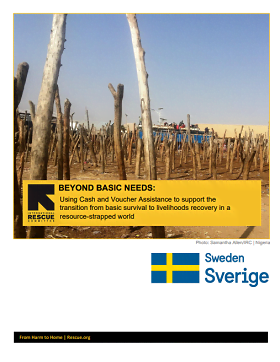
Beyond Basic Needs: Using Cash and Voucher Assistance to Support the Transition from Basic Survival to Livelihoods Recovery in a Resource-Strapped World
Guidelines and Tools
Do you think of yourself as a “cash” person OR as a “livelihoods” person? An “emergency” practitioner OR a “recovery” practitioner? Or do you find yourself unsatisfied with the often narrow implications of these terms? We’ll never have enough funding to provide basic needs support to everyone who needs it for the entire time they are in need, even if we take advantage of the...
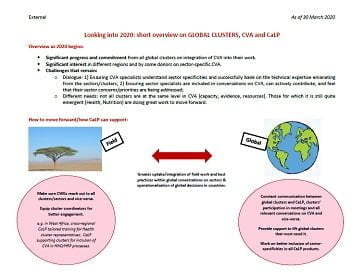
Looking into 2020: short overview on global clusters, CVA and the CALP Network
Presentation
Overview as 2020 begins:
• Significant progress and commitment from all global clusters on integration of CVA into their work.
• Significant interest in different regions and by some donors on sector-specific CVA.
• Challenges that remain:
o Dialogue: 1) Ensuring CVA specialists understand sector specificities and successfully bank on the technical expertise emanating...

Building Evidence to inform the Effective Use of CASH and Voucher Assistance in Emergency Sanitation and Hygiene Programming
Report
An analysis of 5 case studies of utilization of CASH/Voucher Assistance are presented and analysed in the attempt of building evidence on their utilization in emergency WASH Sanitation and HP programming. Findings and recommendations are provided on Coordination, Situation and Response Analysis, Program Design, Implementation, Monitoring and Evaluation.
Últimos recursos

Collaborative Cash Delivery Network – Grand Bargain – Collaboration Agreement Accomplishments 2020
Report
The Collaborative Cash Delivery (CCD) Network is pleased to present its achievements against the commitments made by our global members’ CEOs at the 2019 Grand Bargain Summit as part of our global collaboration agreement. We know we are better together, and in this time of increasing pressure on the...
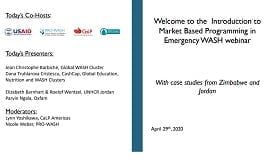
Introduction to Market Based Programming in Emergency WASH
Webinar recording
The recordings of webinar are available in English , Spanish, French, and Arabic. The webinar was co-hosted by the Global WASH Cluster, PRO-WASH and the CALP Network in May and June 2020. The webinar introduced how market based programming can be used in emergency WASH, provide an overview of...
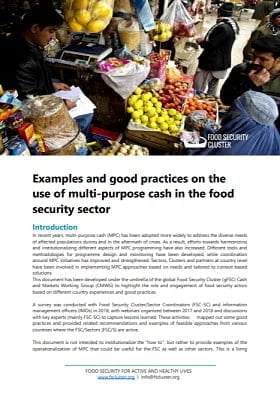
Examples and Good Practices on the Use of Multi-Purpose Cash in the Food Security Sector
Guidelines and Tools
This global Food Security Cluster (gFSC) document was produced by the Cash and Markets Working Group (CMWG) to highlight the role and engagement of food security actors through different country experiences and good practices.
In recent years, multi-purpose cash (MPC) has been adopted more widely to...

Interim Guidance note on the role of Cash and Voucher Assistance to reduce financial barriers in the response to the COVID-19 pandemic, in contexts targeted by the Global Humanitarian Response Plan COVID-19
Guidelines and Tools
This paper provides general guidance on identifying financial barriers, and considering supply side financing options and complementary CVA within the broader response interventions to Covid-19.
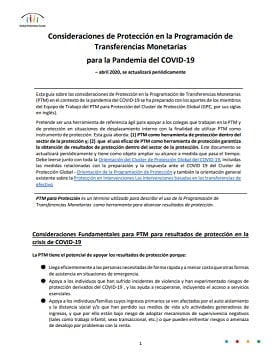
Consideraciones de Protección en la Programación de Transferencias Monetarias para la Pandemia del COVID-19
Guía y herramientas
Esta guía sobre las consideraciones de Protección en la Programación de Transferencias Monetarias (PTM) en el contexto de la pandemia del COVID-19 se ha preparado con los aportes de los miembros del Equipo de Trabajo del PTM para Protección del Cluster de Protección Global (GPC, por sus siglas en...
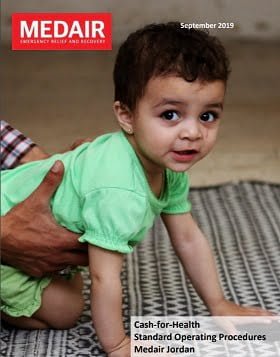
Cash-for-Health Standard Operating Procedures Medair Jordan
Guidelines and Tools
In November 2015, Medair initiated a cash-for-health (C4H) programme in Jordan as a way for vulnerable Syrian refugees to overcome the financial barriers to accessing healthcare in Jordan. A set of standards to deliver C4H has been developed based on past programme experience and this document...
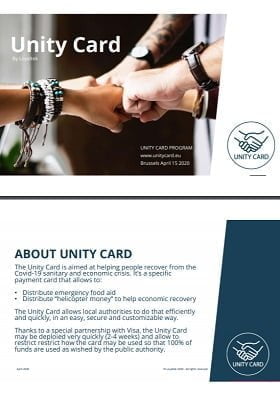
Unity Card
Presentation
In response to NCOVID, we have launched UNITY CARD,
which gives immediate technical support to the deployment of cash aid via this special card payments

La programación basada en el mercado para el sector del agua, saneamiento e higiene
Webinario
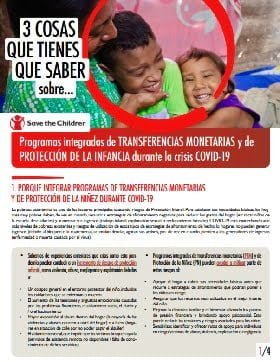
3 Cosas que Saber Sobre… Programas Integrados de Transferencias Monetarias y de Protección de la Infancia Durante la Crisis Covid-19
Guía y herramientas
Esta hoja de consejo interactiva de 4 páginas tiene como objetivo resumir porqué, qué tipo y cómo integrar las transferencias de efectivo y la protección infantil durante COVID-19. Se centra en aspectos claves relacionados con el diseño y la implementación de programas integrados y proporciona...
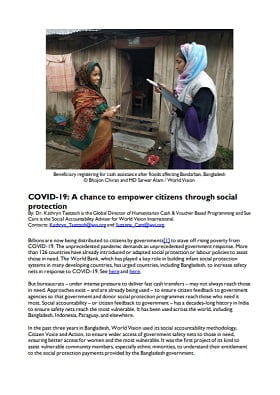
COVID-19: A chance to empower citizens through social protection
Report
Billions of US$ are now being distributed to citizens by governments to stave off deteriorating economic impact and rising poverty from COVID-19. The unprecedented pandemic demands an unprecedented government response. More than 126 countries have already introduced or adapted social protection or labour...

Case Study: Documentation of experiences using CVA for nutrition outcomes in Nigeria
Case Study
This case study was conducted as part of the wider initiative to develop guidance on the use of cash and voucher assistance (CVA) for nutrition outcomes. The case study reflects experiences and lessons learned in the context of Nigeria. It further explores opportunities to improve the nutrition...

Global Education Cluster Note on the use of CVA for EiE in COVID-19 context
Policy paper
Guidance document on the use of CVA for Education in Emergencies in COVID-19 contexts. This note is intended to provide additional insights for education clustercoordinators on the potential uses of CVA for EiE in the current COVID-19 pandemic response under the GHRP COVID-19
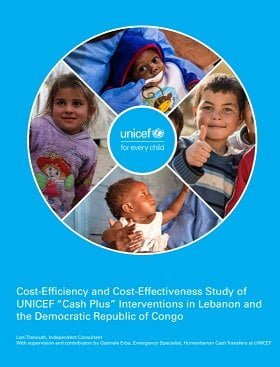
Cost-Efficiency and Cost-Effectiveness Study of UNICEF “Cash Plus” Interventions in Lebanon and the Democratic Republic of Congo.
Policy paper
The combination of basic services delivery and cash transfers is known among humanitarian practitioner as “cash plus”. This approach represents a solid comparative advantage for UNICEF considering its footprint in basic services delivery as well as its commitment to scale up humanitarian cash...

Cash and Voucher Assistance for Health Outcomes
Webinar recording
The Global Health Cluster, the CALP Network, CARE, IRC and KIT organized a webinar on CVA for health outcomes. The aim of the webinar was to enhance participants’ learning of the use of CVA to address financial barriers to healthcare and improve access to Health with research and projects to date. The...

Guidance Note on The Role of Cash and Voucher Assistance to Reduce Financial Barriers in the Response to the COVID-19 Pandemic, in Countries Targeted by the Global Humanitarian Response Plan COVID-19
Guidelines and Tools
The reality is that often people still have direct and indirect healthcare expenditures. This paper will explore different options to address these, and where to consider CVA options. The paper will also give general guidance to other sectors on how to apply epidemic mitigation measures while maintaining...

Looking into 2020: short overview on global clusters, CVA and the CALP Network
Presentation
Overview as 2020 begins:
• Significant progress and commitment from all global clusters on integration of CVA into their work.
• Significant interest in different regions and by some donors on sector-specific CVA.
• Challenges that remain:
o Dialogue: 1) Ensuring CVA specialists...
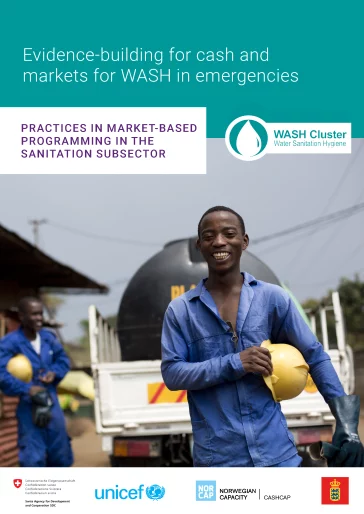
Evidence-building for Cash and Markets for WASH in Emergencies: Practices in market-based programming in the sanitation subsector
Report
This report presents an overview of practices related to the use of market support and cash and voucher assistance (CVA) for sanitation in emergencies. These market-based approaches can have a number of advantages, such as improving the efficiency and effectiveness of emergency sanitation response while...

Evidence-Building for Cash and Markets for WASH in Emergencies: Practices in market-based programming in the hygiene subsector
Report
This report presents an overview of practices related to the use of market support and cash and voucher assistance (CVA) modalities for hygiene in humanitarian crises. These market-based approaches can have a number of advantages, such as improving the efficiency and effectiveness of emergency hygiene...

Evidence-Building for Cash and Markets for WASH in Emergencies: Practices in market-based programming in the water subsector
Report
Humanitarian water, sanitation and hygiene (WASH) practitioners are increasingly using market-based programming (MBP) to deliver safe water in emergency response, with interventions that are designed to work through, or support, local water markets. These market-based approaches have a number of...

Recopilación de pruebas sobre las programs de transferencias monetarias y los mercados para WASH en situaciones de emergencia: Resumen de conclusiones
Informe
Este informe tiene los siguientes objetivos específicos: presentar las prácticas actuales (y las lagunas en la práctica) del uso de las Transferencias Monetarias Multipropósito (TMM) para resultados de WASH en emergencias, identificando los contextos y condiciones en los que se utilizan las TMM y...


